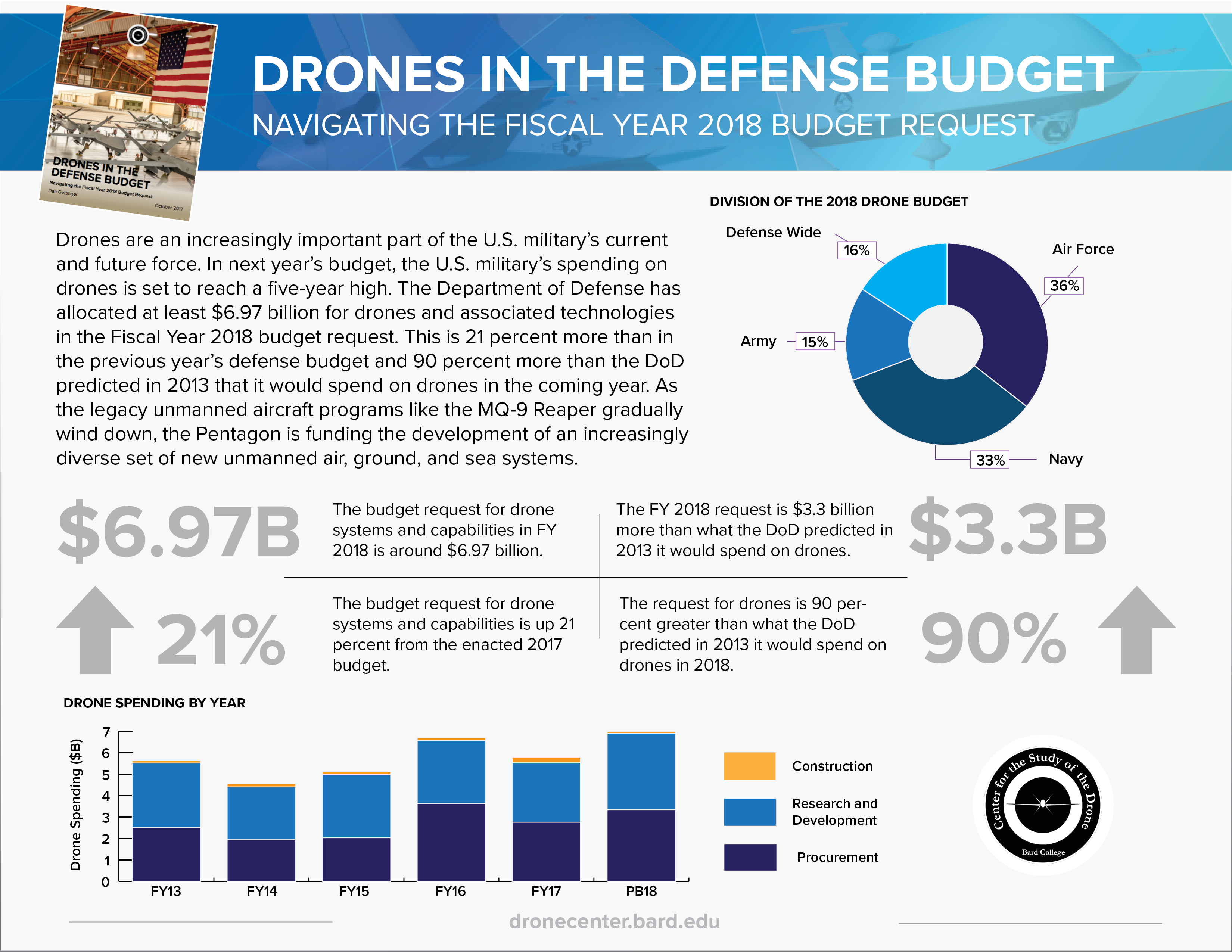Read the press release for this report.
For our study on drone spending in the proposed FY 2019 defense budget, click here.
[gview file=”http://dronecenter.bard.edu/files/2018/01/Drones-Defense-Budget-2018-Web.pdf”]
If the document does not immediately appear, please refresh the page or click “download.”
The U.S. military’s spending on drones is set to reach a five-year high. The Department of Defense Fiscal Year 2018 budget request contains $6.97 billion for drone-related procurement, research and development, and system-specific construction. The President’s Budget 2018 maintains funding for existing unmanned aircraft at roughly the same level as the previous year and increases funding for research and development. It lays the groundwork for programs that will develop new unmanned ground and maritime drones, as well as the next generation of unmanned aircraft.
This report examines the U.S. military’s proposed budget for drones in Fiscal Year 2018. It considers underlying trends and recent developments that will affect the future development of unmanned systems in the air, ground, and sea. The report compares the President’s Budget 2018 to the past five years of military drone spending in order to understand how drone spending has evolved over time. The report is based on a catalogue of over 400 budget line items and projects that have collectively received a total of $34.6 billion in funding between Fiscal Year 2013 and 2018.
In order to gauge how much the U.S. military spends on drones, we take a holistic approach to studying the Pentagon’s budget requests. Reports of drone spending are frequently based on the budgets of a few prominent platforms such as the Air Force’s Reaper or the Navy’s Triton. For example, the Pentagon’s annual summary of funding for major defense systems notes that $2.6 billion has been allocated to existing unmanned aircraft in FY 2018. However, that estimate excludes certain items such as the procurement of spare parts for existing drone systems, as well as the panoply of emerging drone systems and capabilities. By studying budget items both large and small—half of the drone line items in our PB18 dataset are allocated $10 million or less—this report provides the closest complete public account of how much the Pentagon has allocated to drone systems and to capabilities such as autonomous drones, swarms, and advanced robotics.
While the Fiscal Year 2018 budget request funds some of these emerging technologies and capabilities, the future of some of these programs is not a done deal. Congress is currently debating spending levels for existing unmanned platforms and for new drones like the MQ-25 Stingray, a carrier-based aerial refueler drone, and the Large Displacement Unmanned Undersea Vehicle. These debates could delay plans to begin some programs or prolong the life of others. This report offers stakeholders and the public a guide to understanding how funding is divided between different, at times competing priorities and what changes to these programs could mean for their future.
The future drone force may not look too much like the military drones of today. Small quadrotor drones and bulky, pack-carrying robots could accompany infantry while jet-powered strike drones may serve as wingmen to future fighter pilots. Submarine-like underwater drones equipped with aerial drones could stalk enemy fleets or patrol coastlines. All of these scenarios are backed by millions in DoD funding in the President’s Budget 2018. Later this year, the Pentagon will release a new strategy document that will map its plans for the acquisition and use of military drones, the first since 2013. As the Department of Defense looks to the future, our data offers a baseline from which to view new developments in drone spending.

For our study on drone spending in the proposed FY 2019 defense budget, click here.
